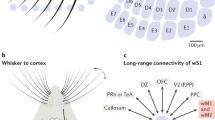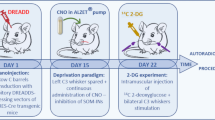Abstract
Synaptic plasticity can be induced easily throughout life in the rodent somatic sensory cortex. Trimming all but two whiskers on one side of an adult rat’s face, called ‘whisker pairing’, causes the active (intact) whiskers to develop a stronger drive on cortical cells in their respective barrel columns, while inactive (trimmed) whisker efficacy is down-regulated. To date, this type of activity-dependent plasticity has been induced by trimming all but two whiskers, letting the rats explore their environment from 1 day to 1 month, after which cortical responses were analyzed physiologically under anesthesia. Such studies have enhanced our understanding of cortical plasticity, but the anesthesia complicates the examination of changes that occur in the first few hours after whisker trimming. Here we assayed the short-term changes that occur in alert, active animals over a period of hours after whisker trimming. The magnitude of barrel cortex evoked responses was measured in response to stimulation of the cut and paired whiskers of rats under several conditions: (a) whisking in air (control), (b) active whisking of an object by the rat, and (c) epochs of passive whisker stimulation to identify the onset of whisker pairing plasticity changes in cortex. The main difference between whisking in air without contact and passive whisker stimulation is that the former condition induces an increased response to stimulation of inactive cut whiskers, while the latter condition increases the responses to the stimulated whiskers. The results support the conclusion that whisker pairing plasticity in barrel cortex occurs within 4 h after whisker trimming in an awake, alert animal.









Similar content being viewed by others
Abbreviations
- AW:
-
Adjacent whisker
- PW:
-
Principal whisker
- RMA:
-
Repeated measurement analysis
- SE:
-
Standard error of the mean
- WP:
-
Whisker pairing
References
Armstrong-James M, Diamond ME, Ebner FF (1994) An innocuous bias in whisker use in adult rats modifies receptive fields of barrel cortex neurons. J Neurosci 14:6978–6991
Baskerville KA, Schweitzer JB, Herron P (1997) Effects of cholinergic depletion on experience-dependent plasticity in the cortex of the rat. Neuroscience 80:1159–1169
Benuskova L, Diamond ME, Ebner FF (1994) Dynamic synaptic modification threshold: computational model of experience-dependent plasticity in adult rat barrel cortex. Proc Natl Acad Sci USA 91:4791–4795
Benuskova L, Rema V, Armstrong-James M, Ebner FF (2001) Theory for normal and impaired experience-dependent plasticity in neocortex of adult rats. Proc Natl Acad Sci USA 98:2797–2802
Bermejo RM, Harvey M, Gao P, Zeigler HP (1996) Conditioned whisking in the rat. Somatosens Mot Res 13:225–233
Bermejo RM, Zeigler HP (2000) “Real-time” monitoring of vibrissa contacts during rodent whisking. Somatosens Mot Res 17:373–377
Bienenstock EL, Cooper LN, Munro PW (1982) Theory for the development of neuron selectivity: orientation specificity and binocular interaction in visual cortex. J Neurosci 2:32–48
Brecht M, Schneider M, Manns ID (2005) Silent neurons in sensorimotor cortices: implications for cortical plasticity. In: Ebner FF (ed.) Plasticity in Somatic Sensory-Motor Cortices, CRC Press (in press)
Celikel T, Szostak VA, Feldman DE (2004) Modulation of spike timing by sensory deprivation during induction of cortical map plasticity. Nat Neurosci 7:534–541
Churchill JD, Muja N, Myers WA, Besheer J, Garragthy PE (1998) Somatotopic consolidation: a third phase of reorganization after peripheral nerve injury in adult squirrel monkeys. Exp Brain Res 118:189–196
Delacour J, Houcine O, Talbi B (1987) “Learned” changes in the response of the rat barrel field neurons. Neurosci 23:63–72
Delacour J, Houcine O, Costa JC (1990) Evidence for a cholinergic mechanism of “learned” changes in the responses of barrel field neurons of the awake and undrugged rat. Neurosci 34:1–8
Diamond ME, Armstrong-James M, Ebner FF (1993) Experience-dependent plasticity in adult rat barrel cortex. Proc Natl Acad Sci USA 90:2082–2086
Diamond ME, Huang W, Ebner FF (1994) Laminar comparison of somatosensory cortical plasticity. Science 265:1885–1888
Dykes R, Lamour Y (1988) Neurons without demonstrable receptive fields outnumber neurons having receptive fields in samples from the somatosensory cortex of anesthetized or paralyzed cats and rats. Brain Res 440:133–143
Fanselow EE, Nicolelis MAL (1999) Behavioral modulation of tactile responses in the rat somatosensory system. J Neurosci 19:7603–7616
Friedberg MH, Lee SM, Ebner FF (1999) Modulation of receptive field properties of thalamic somatosensory neurons by depth of anesthesia. J Neurophysiol 81:2243–2252
Garraghty PE, Kaas JH (1991) Functional reorganization in adult monkey thalamus after peripheral nerve injury. Neurorep 2:747–750
Higley MJ, Contreras D (2006) Balanced excitation and inhibition determine spike timing during frequency adaptation. J Neurosci 26:448–457
Huang W, Armstrong-James M, Rema V, Diamond ME, Ebner FF (1998) Contribution of supragranular layers to sensory processing and plasticity in adult rat barrel cortex. J Neuropysiol 80:3261–3271
Kelly MK, Carvell GE, Kodger JM, Simons DJ (1999) Sensory loss by selected whisker removal produces immediate disinhibition in the somatosensory cortex of behaving rats. J Neurosci 19:9117–9125
Lebedev MA, Mirabella G, Erchova I, Diamond ME (2000) Experience-dependent plasticity of rat barrel cortex: redistribution of activity across barrel columns. Cereb Cortex 10:23–31
Levin BE, Craik RL, Hand PJ (1988) The role of norepinephrine in adult rat somatosensory cortical metabolism and plasticity. Brain Res 443:261–271
Lu S-M, Sachdev RN, Picklo M, Robertson D, Ebner FF (1996) Effects of norepinephrine (NE) depletion in the rat barrel cortex. Soc Neurosci Abstr 22:1357
Merzenich MM, Kaas JH, Wall J, Nelson RJ, Sur M, Felleman D (1983) Topographic reorganization of somatosensory cortical area 3b and 1 in adult monkeys following restricted deafferentation. Neurosci 8:33–55
Polley DB, Chen-Bee CH, Frostig RD (1999) Two directions of plasticity in the sensory-deprived adult cortex. Neuron. 24(3):623–37
Recazone GH, Merzenich MM, Jenkins WM, Grajski KA, Dinse HR (1992a) Topographic reorganization of the hand representation in cortical area 3b of owl monkeys trained in a frequency-discrimination task. J Neurophysiol 67:1031–1056
Recazone GH, Merzenich MM, Jenkins WM (1992b) Frequency discrimination training engaging a restricted skin surface results in an emergence of a cutaneous response zone in cortical area 3a. J Neurophysiol 67:1057–1070
Recazone GH, Merzenich MM, Schreiner SC (1992c) Changes in the distributed temporal response properties of SI cortical neurons reflect improvements in performance on a temporally based tactile discrimination task. J Neurophysiol 67:1071–1091
Rema V, Armstrong-James M, Ebner FF (1998) Experience-dependent plasticity of adult rat S-I cortex requires local NMDA receptor. J Neurosci 18:10196–10206
Rema V, Ebner FF (1999) Effect of enriched environment rearing on impairments in cortical excitability and plasticity after prenatal alcohol exposure. J Neuroscience 19:10993–11006
Rema V, Armstrong-James M, Jenkinson N , Ebner FF (2006) Short exposure to an enriched environment accelerates plasticity in the barrel cortex of adult rats. Neuroscience Apr. 6; [pubmed.gov, Epub. ahead of print]
Sachdev RN, Lu S-M, Wiley RG, Ebner FF (1998) Role of the basal forebrain cholinergic projection in somatosensory cortical plasticity. J Neurophysiol 79:3216–32F
Sachdev RN, Sellien H, Ebner FF (2000) Direct inhibition evoked by whisker stimulation in somatic sensory (SI) barrel field cortex of the awake rat. J Neurophysiol 84:1497–1504
Sellien H, Eshenroder DS, Ebner FF (2005) Effects of bilaterally symmetrical and asymmetrical whisker trimming on adult rat whisker use during exploration. Somatic Sensory Motor Res 22:97–114
Sheth BR, Moore CI, Sur M (1998) Temporal modulation of spatial borders in rat barrel cortex. J Neurophysiol 79:464–470
Simons DJ, Carvell GE, Hershey AE, Bryant DP (1992) Responses of barrel cortex neurons in awake rats and effects of urethane anesthesia. Exp Brain Res 91:259–272
Swadlow HA (1989) Efferent neurons and suspected interneurons in SI vibrissa cortex of the awake rabbit: receptive fields and axonal properties. J Neurophysiol 62:288–308
Swadlow HA, Hicks TP (1997) Subthreshold receptive fields and baseline excitability of “silent” SI callosal neurons in awake rabbits: contributions of AMPA/kainite and NMDA receptors. Exp Brain Res 115:403–409
Welker E, Soriano E, Van der Loos H (1989) Plasticity in the barrel cortex of the adult mouse: effects of peripheral deprivation on GAD-immunoreactivity. Exp Brain Res 74:441–452
Wong-Riley MT, Welt C (1980) Histochemical changes in cytochrome oxidase of cortical barrels after vibrissal removal in neonatal and adult mice. Proc Natl Acad Sci USA 77:2333–2337
Acknowledgments
We thank Mark Maguire and Donna Eshenroder for their help during recordings sessions. This work was supported by NIH grant NS 25907.
Author information
Authors and Affiliations
Corresponding author
Rights and permissions
About this article
Cite this article
Sellien, H., Ebner, F.F. Rapid plasticity follows whisker pairing in barrel cortex of the awake rat. Exp Brain Res 177, 1–14 (2007). https://doi.org/10.1007/s00221-006-0644-y
Received:
Accepted:
Published:
Issue Date:
DOI: https://doi.org/10.1007/s00221-006-0644-y




